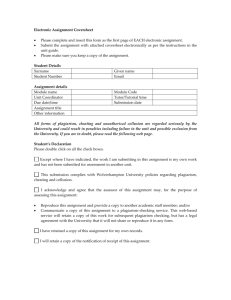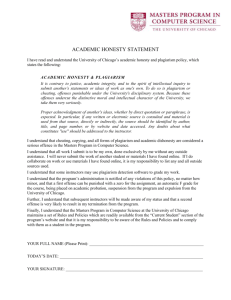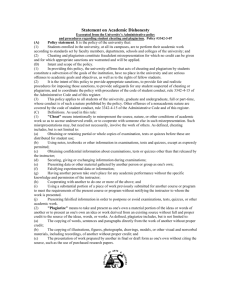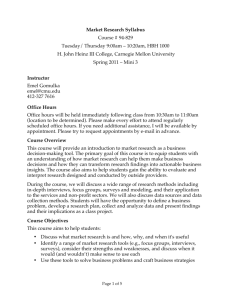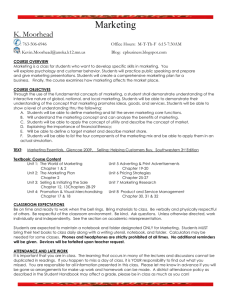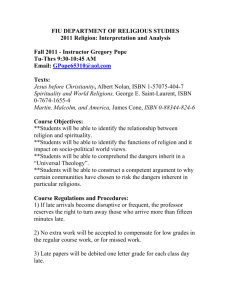Technological Impact on Academic Integrity
advertisement
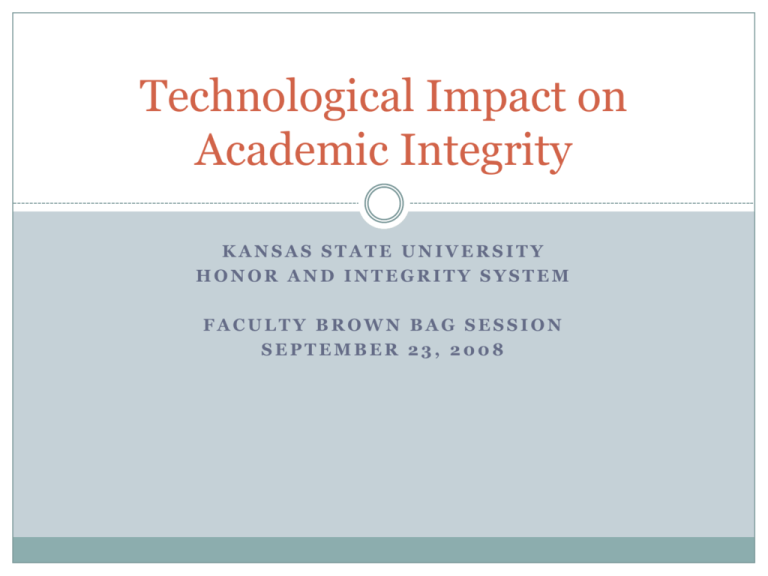
Technological Impact on Academic Integrity KANSAS STATE UNIVERSITY HONOR AND INTEGRITY SYSTEM FACULTY BROWN BAG SESSION SEPTEMBER 23, 2008 Overview Out-of-class technology In-class technology Distance Education What should faculty do? Questions for discussion Out-of-Class Buying papers online Cutting and Pasting from online Computer hacking (files, K-State online, passwords, etc) On-line Papers (just a few examples) Customwritings.com “The Art of Relieving Student’s Pain” All grade levels Directessay.com Buy-thesis.com Custom-essay.net “100% FREE of Plagiarism” Students have the option of how much to buy (outline, literature review, entire paper, etc.) as well as have someone who has the same native language write the paper. Intentional Cutting and Pasting Online Research Wikipedia Google Ask.com Library Databases Ctrl-C and Ctrl-V Potentially modifying few words (misunderstanding of plagiarism) Technological Hacking K-State Online (unpublished material) Passwords Lab Computers (not logging off) Borrowing of Technology (laptops, calculators, etc.) Files through K-State Networks In Class Cell Phones Cameras PDAs Livescribe's Pulse Smartpen Graphing Calculators Blackberries Using Technology to prepare for in class exam http://gizmodo.com/349511/livescribe-pulse-smartpendigitally-copies-notes-records-3d-audio Cell Phones Text Messaging Friends Google Cha Cha Pictures Silent mode http://www.mobilewhack.com/images/lg_vx5200_cell_phone_1.jpg PDAs Microsoft Word Notepad Calculator Web Connection Bluetooth Technology http://www.imagecows.com/uploads/f460-HPiPAQ112classic-handheld-pda.jpg Graphing Calculators Storing formulas For retrieval For use in the calculator Storing text http://www.inkino.co.uk/zen/images/HP49g.jpg Blackberries Web Surfing E-mail Text Messaging Pictures Calculator File Storage http://www.boygeniusreport.com/wpcontent/uploads/image/vzw-blackberrycurve-8330.jpg A “Simple” Printer This paper is printed with size 4-pt. font. http://csta.villanova.edu/CITIDEL/bitstream/10117/209/3/AcademicDi shonesty_SIGCSE2003.pdf http://csta.villanova.edu/CITIDEL/bitstream/10117/209/3 /AcademicDishonesty_SIGCSE2003.pdf Distance Education Verification of student Proctoring Outside resources in exams/assignments Options for Faculty Plagiarism Detection Software Assignments with specific goals/objectives (from “E-cheating”) Know what is online before the assignment (from “E-cheating”) Give students enough time to complete assignment (from “Echeating”) Oral exams / presentations that describe research process (from “E-cheating”) Awareness of Technology (From “Wired for Cheating”) Create multiple versions of exams (From “Wired for Cheating”) Ban electronic equipment during an exam (From “Wired for Cheating”) Educational Opportunities for Faculty Explain Honor and Integrity (from “E-cheating”) Define Plagiarism in your classroom Other Resources Pictures from www.amazon.com Pictures from www.amazon.com References Lass, R.N., Cera, C.D., Nanjappa, A., Char, B., Popyack, J., Herrmann, N., & Zoski, P. (2003, February). Academic Dishonesty in a High-Tech Environment. Session presented at SIGCSE Technical Symposium on Computer Science Education, Reno, Nevada. Retrieved September 20, 2008 from http://hdl.handle.net/10117/209 Martin, D.F. (2005). Plagiarism and technology: A tool for coping with plagiarism. Journal of Education for Business, 80 (3), 149-152. McMurtry, K. (2001). E-cheating: Combating a 21st century challenge. THE Journal (Technological Horizons in Education), 29 (4), 36-41. Moran, C. (2008, September 23). Cellphones, handy tools for emergency alerts, can be used for cheating. The Chronicle of Higher Education. Retrieved September 23, 2008 from http://chronicle.com/free/2008/09/4705n.htm Wired for cheating. (2004). The Chronicle of Higher Education, 50 (45). Secondary Resources Campbell, S.W. (2006). Perceptions of mobile phones in college classrooms: Ringing, cheating, and classroom policy. Communication Education, 55(3), 280-294. Etter, S., Cramer, J.J., Finn, S. (2006). Origins of academic dishonesty: Ethical orientations and personality factors associated with attitudes about cheating with information technology. Journal of Research on Technology in Education, 39(2), 133-155. Gismondi, A. (2006). The downside of the internet: Cheating and technology in higher education. Journal of College & Character, 7(5), 1-4. Additional Information This information will be posted online at www.ksu.edu/honor Contact information: Dr. David Allen, director, dallen@ksu.edu Dr. Camilla Roberts, assistant director, chjones@ksu.edu Honor & Integrity Office, 532-2595 Questions for Discussion What are some ways that you have worked with students to uphold academic integrity in the technological advanced time? What forms of technical concerns do you see in your classroom? What successes and challenges have you had in your classroom in regards to academic integrity and technology? Next Brown Bags Wednesday, October 22 in the Directors Conference Rooms of the Union (A New Definition of Plagiarism) Thursday, November 20 in the Directors Conference Rooms of the Union (When Academic Integrity is Grey)
